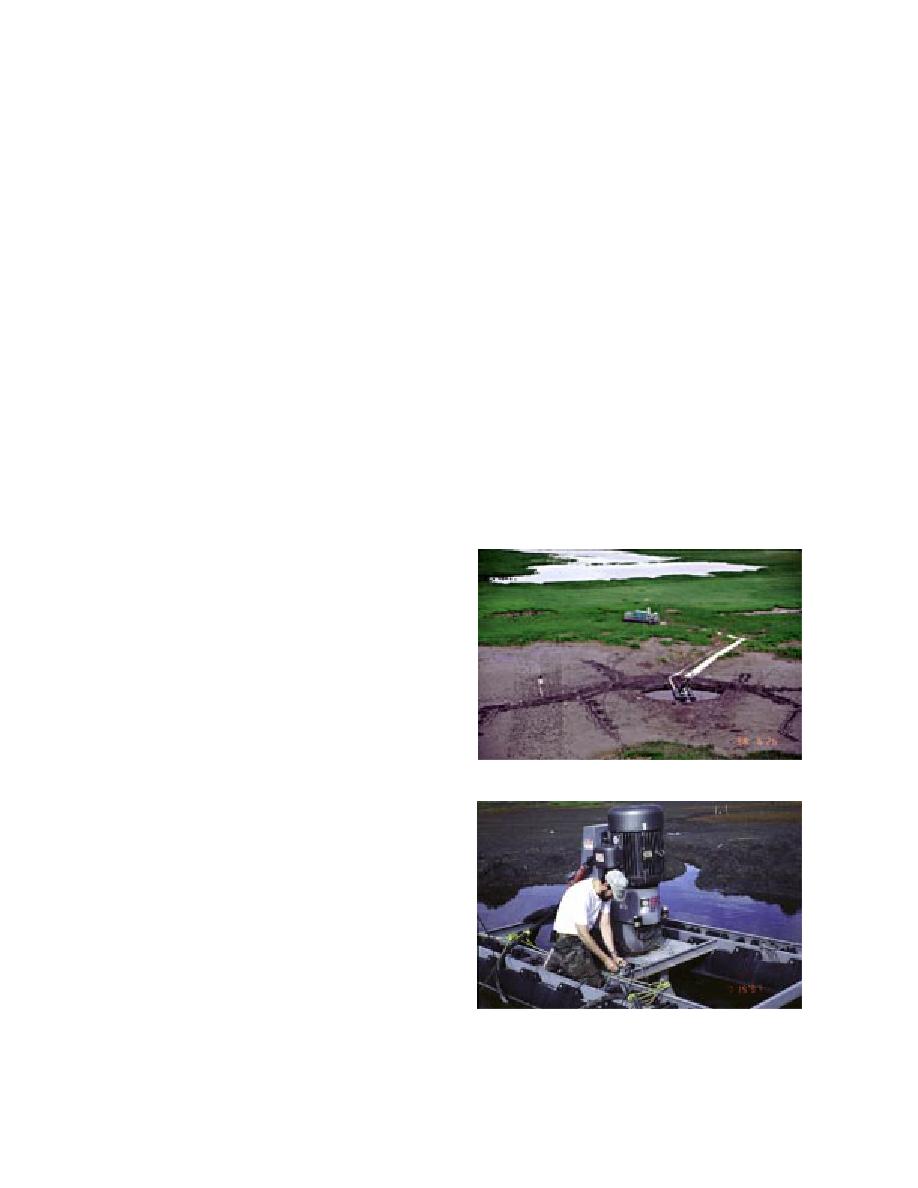
Pond draining: pumping
the danger from unexploded ordnance, the time
Temporary pond draining by pumping was an
and manpower requirements, and the environ-
intriguing alternative to ditching. Theoretically, it
mental impact all served to reduce the desirabil-
has the same positive benefits of permanent
ity of this option. Although effective in removing
draining in that the habitat will be removed so
the contaminant, dredging was too time consum-
that waterfowl will not feed in the contaminated
ing, dangerous, and costly to be considered fur-
sediments once the water is removed. However,
ther. The one remediation option remaining to be
it will not permanently remove the pond as habi-
tried at the time was wide-scale pond pumping to
tat, allowing for the eventual restoration of the
enhance natural attenuation.
pond after the treatment is over. The threshold
A 126-L/s pump system had been built to
into the pond basin won't be lowered, as hap-
specification for Eagle River Flats in 1995. This is
pened with the excavation of a drainage ditch.
the system mentioned above that had originally
Thus, the pond basin is not subjected to flooding
been designed to operate in Pond 109. This pump
during normally nonflooding high tides through-
system is composed of two major components: a
out the summer. Once the pond is pumped out
pump unit consisting of a 15-cm (6-in.) open-
and kept drained, the pond bottom sediments
impeller centrifugal pump on floats and an 80-
can be treated in-situ through natural attenua-
kW generator set (genset) with fuel tanks, also on
tion. Based on the work in laboratory and the in-
floats (Fig. 7). The two units are connected to-
termittent ponds west of Pond 183, we knew that
gether by a four-conductor power cord, 70 m in
substantial sublimation and oxidation of the
length, and a control wire. The control wire inter-
white phosphorus can be achieved if we can keep
faces between the genset control and float
the pond sediments unsaturated and the sedi-
switches mounted on or near the pump.
ment temperature above about 15C for a total of
The pump is separated from the genset to pre-
about thirty cumulative days over a season. Com-
plete decontamination of a pond's surface sedi-
ment can be expected with three to five complete
seasons of treatment. Unknowns associated with
pond pumping included rates of recharge into
the ponds from groundwater and rates of inflow
from the surrounding marsh areas. A pump sys-
tem was designed and ordered to be tested in
Pond 109 in 1995. Contracting delays and then
funding constraints put the pond pumping study
on hold, and Pond 109 was permanently drained
using explosive excavation of a drainage ditch.
The remainder of this report describes and dis-
cusses the pond pumping project at Eagle River
a. System installed in Pond 290. Note datalogger (left).
Flats and the associated sampling program used
to verify the efficacy of the method. As stated in
the Introduction, pond pumping has been chosen
as the main method of remediation at ERF based
on the work described below.
CONTROLLED POND DRAINING
FEASIBILITY STUDY
Initial study deployment of a
pump system (1997)
In 1996, it became clear to both the Ft. Richard-
son's Remedial Project Managers and the investi-
gators involved with the dredge project that
b. Close-up of floating pump in sump.
dredging was not going to be feasible at ERF. The
Figure 7. Autonomous pumping system for Eagle
widely scattered contaminant, the presence of
River Flats.
large amounts of vegetation and woody debris,
8





 Previous Page
Previous Page
